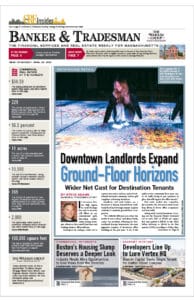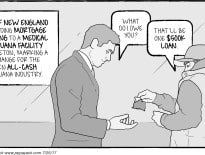Under Massachusetts common law in effect since 1860, property owners have no duty to repair or warn of hazards on an abutting public sidewalk.
This long-established rule was recently addressed by the Massachusetts Appeals Court in Halbach v. Normandy Real Estate Partners. In this case, the plaintiff, Halbach, suffered serious injuries as a result of his fall on uneven payment on the public sidewalk adjacent to the John Hancock Garage, a commercial parking garage on Clarendon Street in Boston. Halbach sued the owners of the garage and its property manager, claiming that the defendants were negligent in their “ownership, control, maintenance and/or inspection” of the sidewalk and their “failure to keep … the walkway free from defects and conditions rendering it unsafe.” Defendants were granted summary judgment by the trial judge based on the long-standing Massachusetts rule referred to above.
On appeal, the trial judge’s ruling was upheld by the Massachusetts Appeals Court, even though there was evidence that the property manager corrected the uneven pavement after Halbach’s fall. In a concurring opinion, Judge James Milkey suggested that the SJC might want to alter the common law rule, and stated that his separate opinion was written “to note that the plaintiffs have a more forceful case for such change in the law than the majority opinion suggests.”
While conceding that public sidewalks are treated as part of the public highways and that town ways shall be kept in repair at the expense of the town where they are situated, Milkey cited the fact that municipalities regularly look to private property owners to keep sidewalks adjacent to their property free from snow and ice so that they are passable and safe. In addition, he pointed out that most commercial property owners accept responsibility for adjoining public sidewalks, as evidenced by the property manager’s repair of the sidewalk after Halbach’s accident.
“In short, at least in the context of commercial property, the reality is that the world principally looks to private property owners to make sure that the sidewalks bordering their property are safe. It is far from self-evident why – under modern tort principles – the law should not follow suit,” he wrote.
Despite Milkey’s ardent recommendation that the SJC reconsider the common law rule regarding public sidewalks, the SJC denied further appellate review this past April.
So where does this leave individuals like Halbach who are injured on public sidewalks? Under G.L.c. 84, §15, the maximum recovery for a private party against a Massachusetts city or town for injuries due to a defect on public ways is $5,000.
On the other hand, many cities and towns like Boston have enacted ordinances requiring owners to clear snow and ice from the abutting public sidewalks. What if the individual is injured because an abutting owner failed to keep the sidewalk free from snow and ice in violation of a municipal ordinance requiring its removal? While generally a violation of a statute or ordinance is evidence of negligence, it has been held that ordinances which require abutting owners to remove snow and ice from sidewalks are for the benefit of the community at large and not for persons who fall as a result of unremoved snow and ice. “Any obligation imposed by the ordinance runs to the municipality and not a member of the travelling public.” Gamere v. 236 Commonwealth Ave. Condominium Assn., 19 Mass. App. Ct. 359, 361 (1985).
Unless the SJC has a change of heart and revises the existing common law, as suggested by Milkey, it would seem that the best way to provide relief to individuals like Halbach would be for the Legislature to enact a statute imposing responsibility for the repair and maintenance of public sidewalks on abutting owners, or at least on commercial owners. Such legislation could be challenged because, according to the Gamere case, it is the responsibility of cities and towns to keep the public ways in reasonably safe condition for travelers and that duty may not be delegated to others. Alternatively, the Legislature could amend G.L.c. 84, §15 either to increase the maximum recovery permitted to injured individuals or to abolish altogether the $5,000 cap that currently exists.
Given the current shortfall of revenues for the commonwealth and its various cities and towns, the traveling public should best traverse carefully over those cracks and defects in public sidewalks.
Edward M. Bloom is a partner in Sherin and Lodgen’s Real Estate Department. He concentrates his practice on the development, sale, leasing and mortgaging of residential, office, shopping center, industrial and condominium properties. He can be contacted at embloom@sherin.com.







